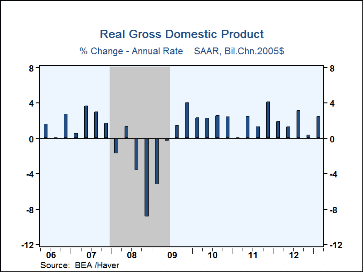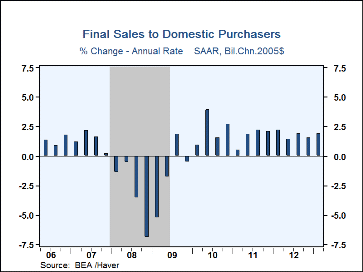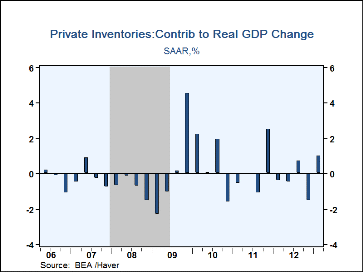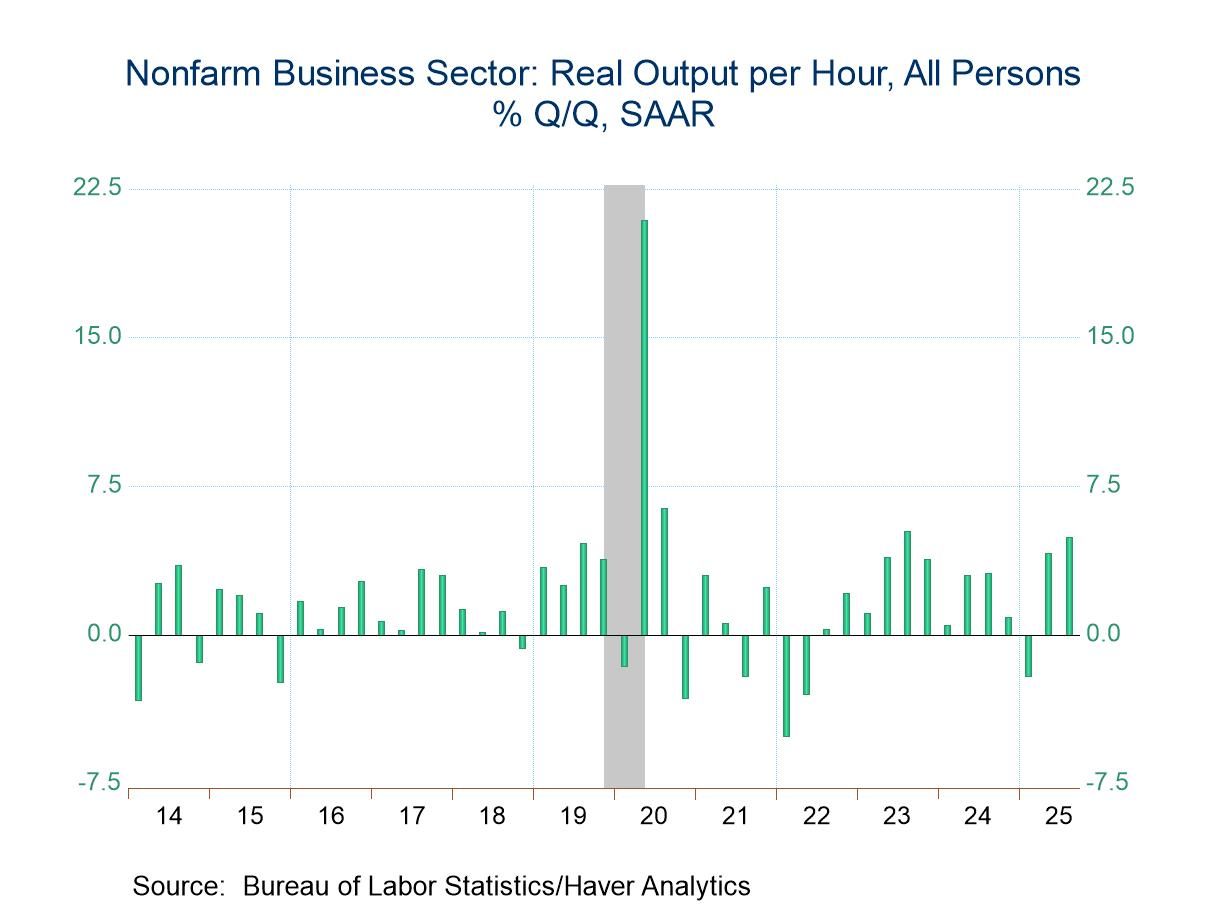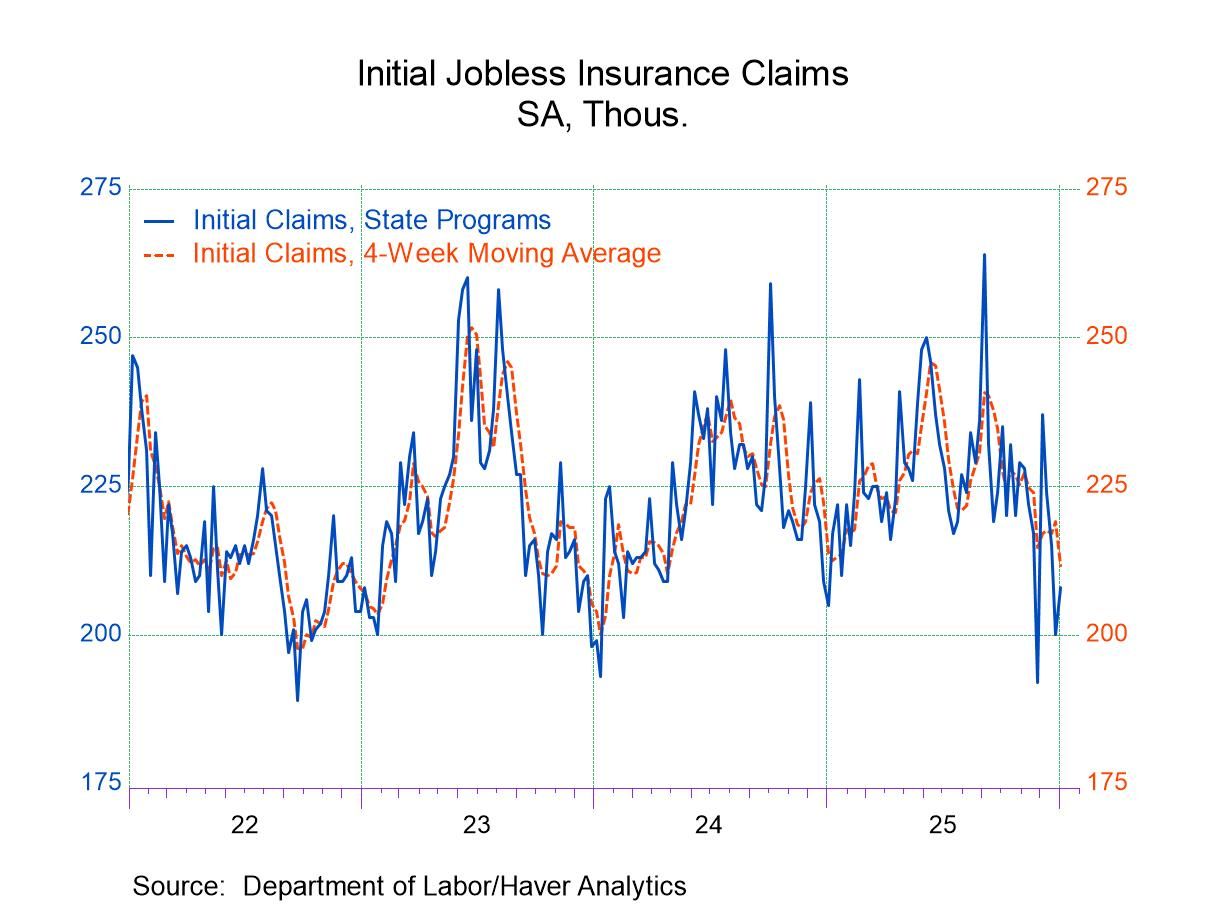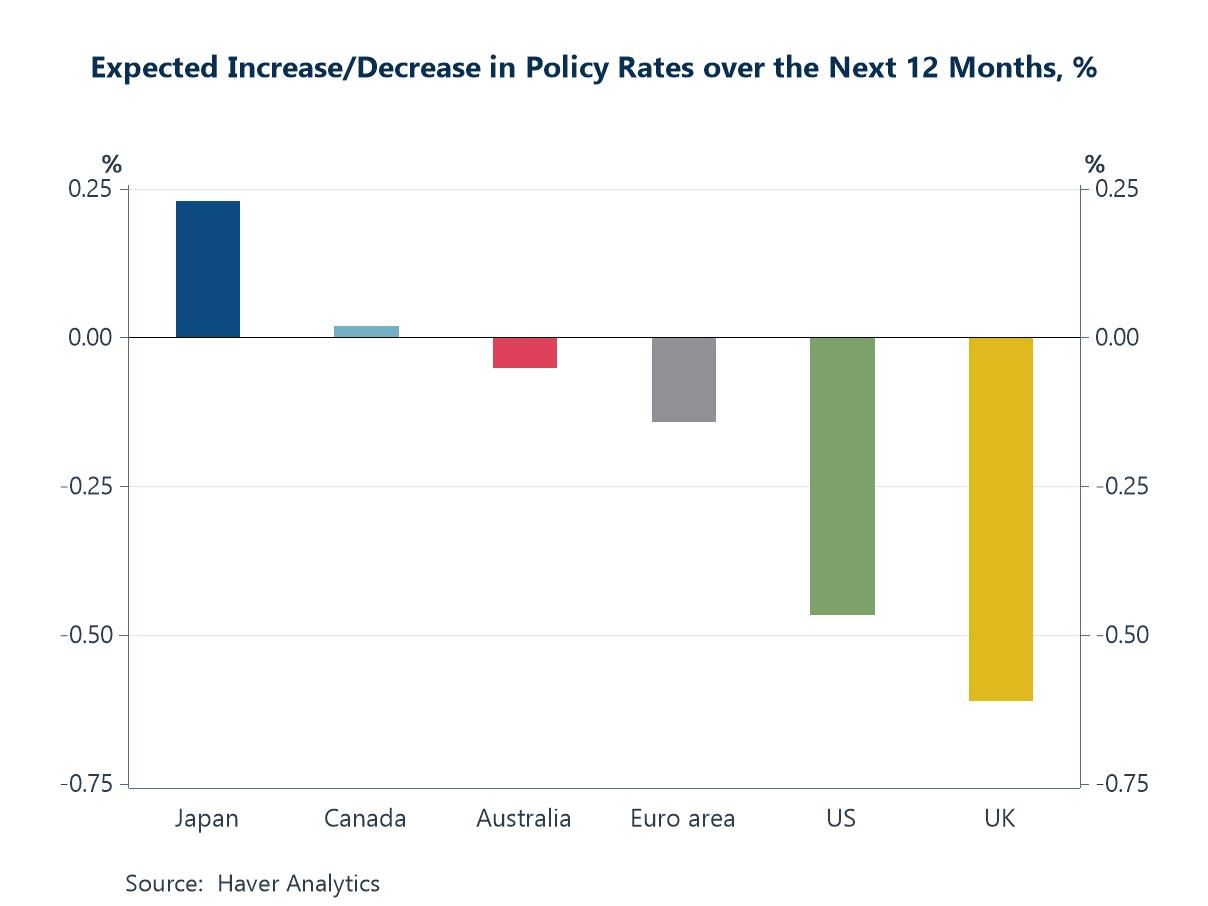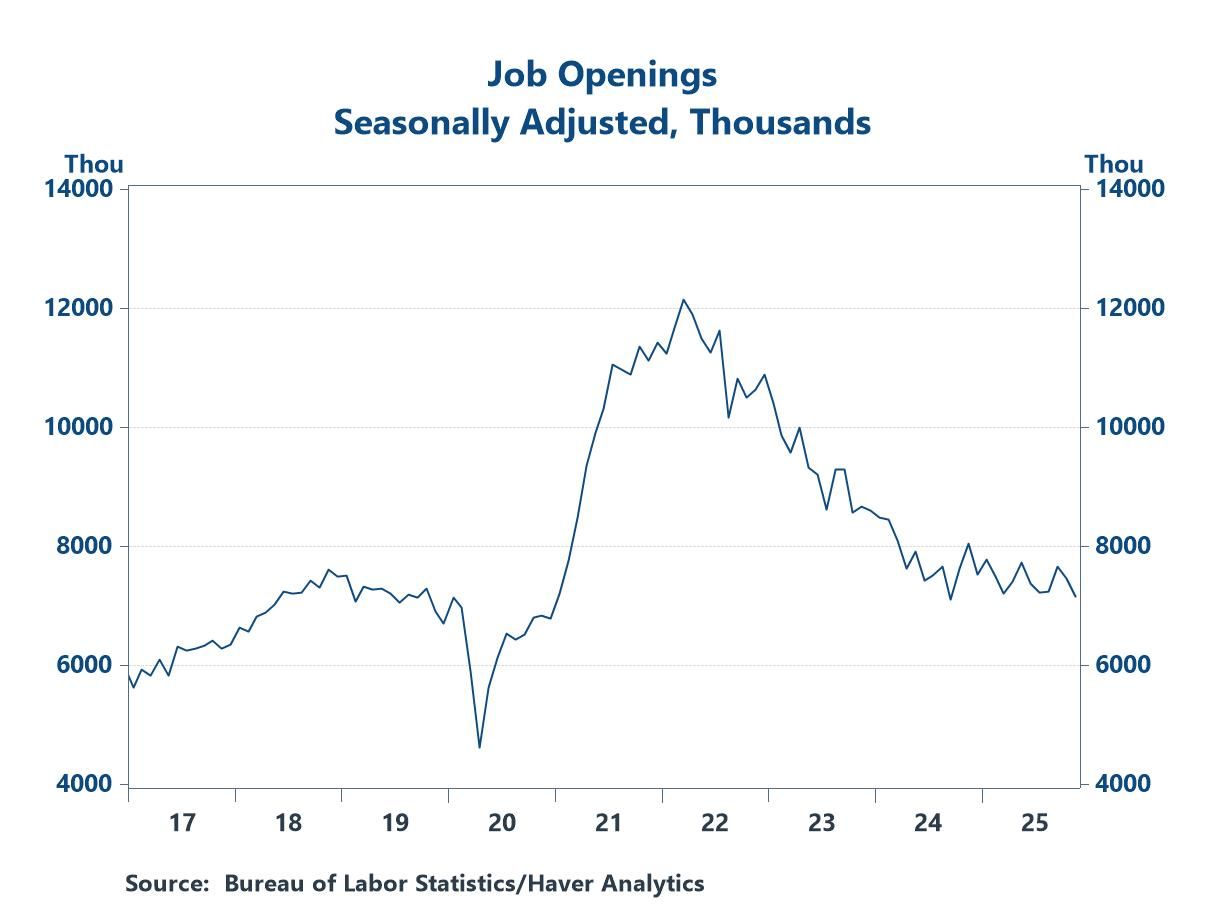 Global| Apr 26 2013
Global| Apr 26 2013U.S. GDP Growth Improves With Inventory Accumulation but Government Outlays Decline
by:Tom Moeller
|in:Economy in Brief
Summary
Economic growth rebounded during Q1'13 as businesses replenished inventories depleted during Q4'12. Real GDP growth of 2.5% last quarter (1.8% y/y) followed a tepid 0.4% increase at the end of the year. Expectations were for a 3.1% [...]
Economic growth rebounded during Q1'13 as businesses replenished inventories depleted during Q4'12. Real GDP growth of 2.5% last quarter (1.8% y/y) followed a tepid 0.4% increase at the end of the year. Expectations were for a 3.1% rise. Holding back final demand were military outlays which declined sharply for the second consecutive quarter. Foreign trade account deterioration also subtracted from growth. To the plus side were consumer spending and residential investment. The GDP chain price index rose moderately (1.2%) for the second consecutive quarter.
While boosting growth last quarter, the effect due to inventories was limited to 1.0 percentage points. Businesses are clearly keeping close tabs on restocking as this did not recoup the 1.5 point subtraction during Q4. Also disappointing was a 0.5 percentage point subtraction from growth due to trade deficit deterioration. It occurred as imports rose at a 5.4% rate (0.8% y/y) but exports gained a lesser 2.9% (1.8% y/y).
Also disappointing was a modest 1.9% rise (1.7% y/y) in final sales to domestic purchasers. Growth was held back by a 4.1% (-2.1% y/y) decline in government purchases. This drop owed to an 11.5% shortfall (-6.1% y/y) in national defense spending which was accompanied by a 1.3% decline (-0.9% y/y) in state & local government outlays.
Final sales to private domestic purchasers continued firm, posting a 3.3% rise (2.6% y/y) after Q4's 3.6% gain. A firmer 3.2% increase (2.0% y/y) in personal spending was led by a 10.6% advance (7.7% y/y) in motor vehicle purchases. Consumption of home furnishings rose at a 3.5% rate (3.1% y/y) but apparel consumption increased a lesser 1.4% (-0.0% y/y). Continuing strong was residential investment, up at a 12.6% rate (13.0% y/y), but business fixed investment growth eased to 2.1% (4.1% y/y) following a 13.1% rise during Q4.
The GDP chain price index matched expectations and rose at a modest 1.2% rate (1.6% y/y). That followed a 1.0% Q4 rise. This modest gain was largely influenced by a 0.9% increase (1.2% y/y) in the PCE price index, held back by lower energy prices. A firmer 5.2% rise (3.2% y/y) in the residential price index was countered by a 0.6% uptick (1.0% y/y) in the business fixed investment price index.
The latest GDP figures can be found in Haver's USECON and USNA databases; USNA contains basically all of the Bureau of Economic Analysis' detail on the national accounts, including the new integrated economics accounts and the recently added GDP data for U.S. Territories. The Consensus estimates can be found in AS1REPNA.
| Chained 2005 $, %, AR | Q1'13 (Advance) | Q4'12 | Q3'12 | Q1 Y/Y | 2012 | 2011 | 2010 | |
|---|---|---|---|---|---|---|---|---|
| Gross Domestic Product | 2.5 | 0.4 | 3.1 | 1.8 | 2.2 | 1.8 | 2.4 | |
| Inventory Effect | 1.0 | -1.5 | 0.7 | -0.1 | 0.2 | -0.2 | 1.5 | |
| Final Sales | 1.5 | 1.9 | 2.4 | 1.9 | 2.1 | 2.0 | 0.9 | |
| Foreign Trade Effect | -0.5 | 0.3 | 0.4 | 0.2 | 0.1 | 0.2 | -0.4 | |
| Domestic Final Sales | 1.9 | 1.5 | 1.9 | 1.7 | 1.9 | 1.8 | 1.3 | |
| Demand Components | ||||||||
| Personal Consumption | 3.2 | 1.8 | 1.6 | 2.0 | 1.9 | 2.5 | 1.8 | |
| Business Fixed Investment | 2.1 | 13.1 | -1.8 | 4.1 | 8.0 | 8.6 | 0.7 | |
| Residential Investment | 12.6 | 17.5 | 13.6 | 13.0 | 12.1 | -1.4 | -3.1 | |
| Government Spending | -4.1 | -7.0 | 3.9 | -2.1 | -1.7 | -3.1 | 0.6 | |
| Chain-Type Price Index | ||||||||
| GDP | 1.2 | 1.0 | 2.7 | 1.6 | 1.8 | 2.1 | 1.3 | |
| Personal Consumption Expenditures | 0.9 | 1.6 | 1.6 | 1.2 | 1.8 | 2.4 | 1.9 | |
| PCE less Food & Energy | 1.2 | 1.0 | 1.1 | 1.3 | 1.7 | 1.4 | 1.5 | |
Tom Moeller
AuthorMore in Author Profile »Prior to joining Haver Analytics in 2000, Mr. Moeller worked as the Economist at Chancellor Capital Management from 1985 to 1999. There, he developed comprehensive economic forecasts and interpreted economic data for equity and fixed income portfolio managers. Also at Chancellor, Mr. Moeller worked as an equity analyst and was responsible for researching and rating companies in the economically sensitive automobile and housing industries for investment in Chancellor’s equity portfolio. Prior to joining Chancellor, Mr. Moeller was an Economist at Citibank from 1979 to 1984. He also analyzed pricing behavior in the metals industry for the Council on Wage and Price Stability in Washington, D.C. In 1999, Mr. Moeller received the award for most accurate forecast from the Forecasters' Club of New York. From 1990 to 1992 he was President of the New York Association for Business Economists. Mr. Moeller earned an M.B.A. in Finance from Fordham University, where he graduated in 1987. He holds a Bachelor of Arts in Economics from George Washington University.


